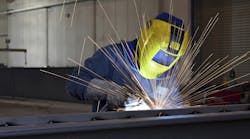How Do Advances in Industrial IoT Impact the Labor Market?
We can’t scroll a page without seeing the latest Smart gadget. Thermostats, refrigerators, lighting systems, and more are all equipped with sensors to help us manage our own lives more efficiently. The Internet of Things (IoT) isn’t going anywhere either. According to a recent study, 79% of U.S. households have at least one connected device. While it’s evident IoT has surpassed the tipping point, that’s nothing compared to how the IoT is changing manufacturing.
IIoT Breaking Records
To understand where IoT is headed, just look to the industrial sector. Twenty-nine billion was invested in industrial IoT (IIoT) in 2015. By 2020, analysts anticipate $70 billion in investments in IIoT technologies. Analysts also predict the quantity of installed IIoT devices to jump from 237 million in 2015 to 923 million, totaling $267 billion in spending. Can you say sensor?
The reason for the surge? Connected devices are helping companies within the industrial sector to increase profitability and productivity hand over fist. According to a 2014 survey, manufacturers who used connected devices between 2013 and 2014 saw a 28.5% increase in profits. The promise of increased profits is driving companies in manufacturing, energy, and more to adopt “Industry 4.0” technologies, and fast. According to Jack in the Box CEO Leonard Comma, “It just makes sense.”
New Possibilities with IIoT
At its core, the IIoT consists of networked devices, sensors, and instruments collecting, transferring, and storing data. The data collected is assessed, and persons or programs find ways to make improvements on the factory floor. It’s a simple concept, but manufacturing plants are finding ways to revolutionize productivity.
Predictive Manufacturing
One of the most widely adopted applications for IIoT technology is predictive manufacturing and condition monitoring. Embedded sensors can monitor metrics—e.g., temperature, sound, and vibration—that can indicate a machine may be in need of maintenance, is operating outside of safe parameters, or will soon reach end of life. Sensors can also trigger an alert if a machine has shut down unexpectedly or if another unexpected variable, such as moisture or movement, has entered the picture.
Instead of waiting until there’s an accident or a machine breaks down, engineers can be proactive with machine maintenance. A team will know exactly which machine is operating abnormally and will have useful data on hand to streamline the troubleshooting process. This boosts productivity for companies by taking the guesswork out of condition monitoring, decreasing the occurrence or duration of hardware breakdown, and eliminating the purchase of equipment before it’s needed.
No wonder manufacturing plants across the globe are adopting IIoT devices. As Comma said, it just makes sense.
Real-Time Energy Management
The energy sector is another industry gobbling up IIoT technology. In power, sensor technology allows for a more real-time assessment of supply and demand, making production more efficient and lessening the footprint of these smart-grid operations. This is particularly helpful for micro-grid applications, such as individual households with solar panels.
The oil and gas industries are also utilizing IIoT for data convergence. Databases in the industry can be siloed. By bringing data together, analysts can better assess real-time conditions of resources and the best plan for the future.
Location Tracking
A third and unexpected application for IIoT technology is location tracking of resources. One executive found his client’s employees spent up to 47% of their time searching for missing tools. Not to fear, IIoT is here.
How to solve this issue? Sensors. IIoT device manufacturers are starting to add location-tracking components to tools. Now, if someone is hoarding the wrench in a desk, coworkers are going to know about it. Aftermarket tracking sensors can also be purchased to “connect” older devices to the cloud. In this way, tool-hunting may become a thing of the past.
What the Surge in IIoT Means for Jobs
While executives and high-level managers celebrate increased profits thanks to advances in IIoT, one must wonder what such widespread adoption of these new technologies means for the labor market. Researchers from the McKinsey Global Institute estimate this AI revolution is happening 10 times faster and on a scale 300 times that of the industrial revolution. It’s thus projected this shift could have approximately 3,000 times the impact of the Industrial Revolution in terms of disruption to society.
Modeling
There are many predictive models used to calculate the impact of the AI revolution on the labor market. The aforementioned example is one method, which bases the potential impact of the current industrial shift on the social disruption projected to be caused by the Industrial Revolution of the 18th and 19th centuries.
However, are other ways of trying to assess the impact on labor. Another approach looks at the potential to replace repetitive tasks by AI technologies. In one paper, it was projected that 47% of U.S. job functions could be replaced by machines over the next 20 years. Researcher Georgios Petropoulos isn’t convinced, though. In a second paper he cites, which looked at the risk of task automation (not the automation of occupations), only 9% of U.S. jobs were found to have the potential to be fully automatable.
The Verdict
Whatever the number, all the data seems to suggest the jobs most at risk of automation are low-to-moderate skilled labor. For example, positions previously responsible for condition monitoring and collection of equipment data may be eliminated, or demand for such positions may decrease in the coming decade.
That said, it doesn’t mean unemployment in the U.S. will surge. In his paper, Petropoulos suggests taking an equilibrium approach. He notes that while jobs in the manufacturing sector may decrease for low-to-medium skilled laborers, the increase in productivity across the industrial sector will lead to the availability of many new jobs in related sectors, thus canceling out or lessening the effect of the automatization.
In Short, Be Flexible
If you or someone you know is working in one of the job functions expected to be eliminated due to automatization, don’t worry. Just as the Industrial Revolution lead to the creation of thousands of new job functions as a result of increased productivity, the AI revolution is expected to do the same. That said, new jobs may open up in fields not yet anticipated. Be flexible and be willing to change. As always, hard work and a good attitude go far in any work environment.
With this, don’t wait until a job is eliminated before taking action. Now is the time to begin discussions with policymakers, labor unions, and the like. Take an active role in shaping the future of industry and no matter what comes, you’ll be better equipped to ride out the storm.


